atomic theory 原子论
原子论

原子论有一种观点,即万物都由二、三个简单的部分所构成。
这种观点起源于公元前4世纪期间原子论的哲学中。
原子论由希腊哲学家卢萨普斯创立,他的弟子德莫克里特更充分地发展了这一哲学观点。
德莫克里特给他的基本粒子命名为原子,意思就是不可分割。
他把原子想象为小而坚硬的粒子,由大小和形状不同的相同物质组成。
在公元前3世纪期间,一位名叫伊彼究鲁的希腊哲学家把德莫克里特原子论融汇到自己的哲学体系之中。
大约公元前50年,罗马哲学家和诗人克里蒂斯在他的诗中提出了原子论的基本原则。
在中世纪这段时间,原子概念在很大程度上被忽略了,部分原因是因为亚里斯多德拒绝接受原子论。
亚里斯多德是古希腊的哲学家,他的理论统治了中世纪的哲学和科学。
然而,原子是形成所有物质基本单位的观点却留存了下来。
在16和17世纪期间,现代科学的缔造者们,如英国的培根和牛顿以及意大利的伽利略都相信原子。
但是这些科学家仅为德莫克里特所描述的原子理论增添了少许内容。
现代原子理论的诞生1750年,出生在现克罗地亚的科学家布斯卡维齐提出,德莫克里特所认为的原子"不可分割"的观点可能是错误的。
布斯卡维齐认为,原子包含更小的部分,而更小的部分中还含有再小的部分,如此下去,直到构成物质的基本结构单元。
他认为这些结构单元肯定是没有大小的几何学上的点。
今天,大多数原子物理学家接受这种想法的现代形式。
当化学成为18世纪末期一门精确科学的时候,原子理论得到了极大的发展。
化学家发现,只能根据某种固定的质量比例将元素组成化合物。
1803年,一位名叫道尔顿的英国化学家提出了一种原子理论,对这一发现进行解释。
道尔顿假设,每种元素都由特别种类的原子构成,并且元素的不同性质是由于它们的原子上存在的差异所致。
他进一步指出,同种元素的所有原子在大小、形状和质量上都是相同的。
根据道尔顿的理论,当原子结合并形成一种特定化合物的时候,总是以特定的数目比例实现。
结果,一种特定化合物的质量组成总是固定不变的。
原子论
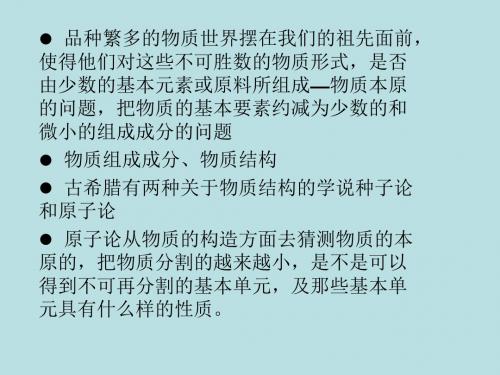
• 近代科学 布鲁诺、伽利略、伽桑狄
• 近代化学 波义耳、斯塔尔、道尔顿 • 经典物理学 光、热素说、安培 • 生物学 希波克拉底、达尔文、孟德尔
• 近代天文学 太阳系的起源
原子论方法与现代科学
• 基本例子研究中的原子论方法 原子核内部还有结构,即从核内部的结构更好的说 明原子结构及其性质。把原子性质归因为次一层 次的核子的运动——原子论方法在新的领域的复 活,德谟克利特的观念对现代自然科学思想方法 的影响
•进入一个固定的模式之中 • 三阶段 德谟克利特——牛顿(自然哲学的思想,作为哲学思想和方 法的原子论与作为科学思想和方法的原子论融合) 伽桑狄(移植到力学中,牛顿机械原子论的建立) 20世纪(影响科学家的活动,决定理论科学家的思想方法) • 原子论给整个自然科学的发展带来的影响是不容低估的 • 原子论方法是一种带有原理性的方法,比任何一个具体的 科学理论的提出都更能震撼自然科学的基础。
很容易说明物体的感 觉性质——性质的不同在于原子的 不同、数量及结合方式的不同
• 理性方法是区分事物感觉性质(多样性)和事物的本质属性(统一性) 的有效方法
。
世界的本原归为原子 及原子自己的运动 ,反对一个外来的 本原或世界没有本原
数学和谐的自然图景 引导人们到上帝那儿 去寻求自然和谐的原因
数的统一性不那么直接
N
• 一切可感觉的特征都归结到原子不同的联合——造成事物的产生,原 子的解散和分离造成事物的灭亡 • 它是一种理性的方法(分析),并不是经验的方法;原子虽然可以当做 物质的,但它是非感觉的,是纯粹理性的;原子和虚空不是经验中的 事物,我们凭借任何仪器或借助感官都无法观测到他们,观念性的, 想象中的 • 它更容易为自然科学家所接受
原子论方法对近代自然科学的影响
原子论是谁提出的
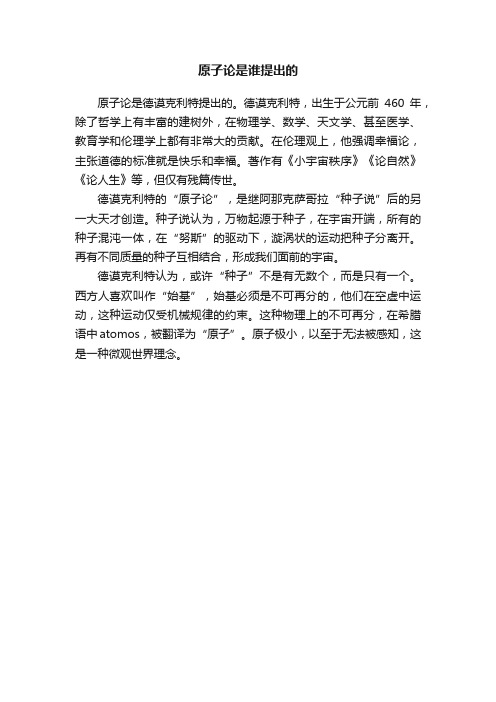
原子论是谁提出的
原子论是德谟克利特提出的。
德谟克利特,出生于公元前460年,除了哲学上有丰富的建树外,在物理学、数学、天文学、甚至医学、教育学和伦理学上都有非常大的贡献。
在伦理观上,他强调幸福论,主张道德的标准就是快乐和幸福。
著作有《小宇宙秩序》《论自然》《论人生》等,但仅有残篇传世。
德谟克利特的“原子论”,是继阿那克萨哥拉“种子说”后的另一大天才创造。
种子说认为,万物起源于种子,在宇宙开端,所有的种子混沌一体,在“努斯”的驱动下,漩涡状的运动把种子分离开。
再有不同质量的种子互相结合,形成我们面前的宇宙。
德谟克利特认为,或许“种子”不是有无数个,而是只有一个。
西方人喜欢叫作“始基”,始基必须是不可再分的,他们在空虚中运动,这种运动仅受机械规律的约束。
这种物理上的不可再分,在希腊语中atomos,被翻译为“原子”。
原子极小,以至于无法被感知,这是一种微观世界理念。
查尔斯·泰勒:《原子论》

经典文本原子论①查尔斯暏泰勒著 曹 帅译 曹 钦校一我想要检视政治的原子论这个议题,或至少澄清这个议题是什么。
我想说明原子论学说是由什么组成的,并考察它们是如何与这个议题联系起来的———也就是说,那些学说是如何被证明或反驳,或至少是被有力地支持或反对的,以及它们可以转而被用来支持什么。
“原子论”这一术语被不太严谨地用于描述这些学说的特征:17世纪兴起的社会契约论学说,以及虽没有使用社会契约概念但继承了这种视野———社会在某种意义上是由主要为实现私人目的的个人组成———的后继学说。
在此意义上,功利主义的某种形式就是这种后继学说。
这一术语也适用于当代的某些学说,它们或者重提社会契约理论,或者在某种程度上试图捍卫个人的优先性及其高于社会的权利,或者展示了一种纯粹工具性的社会观。
当然,任何在政治讨论中被随意使用的术语都能以许多方式被界定。
在不同观点的斗争中,有些术语极易被当成“谴责”的别名,人们甚或应该把它们踢出哲学讨论。
可以说“原子论”就是这样一个术语,因为使用它的似乎全是它的敌人。
即使诺齐克这样的极端个人主义者对它也很不待见,而更青睐作者简介椇查尔斯·泰勒(C h a r l e sT a y l o r ),当代著名哲学家,加拿大麦吉尔大学荣休教授;曹帅,中国社会科学杂志社编辑。
①本文译自C h a r l e sT a y l o r ,“A t o m i s m ,”i n ,:..,A l k i sK o n t o s e d .,U n i v e r s i t y o fT o r o n t oP r e s s ,1979,p p .39-61;R e p r i n t e d i nC h a r l e sT a y l o r ,,C a m b r i d g eU n i -v e r s i t y P r e s s ,p p .187-210。
———译者注5512014年第2期V o l .5 N o .2政治思想史J o u r n a l o f t h eH i s t o r y o f P o l i t i c a lT h o u g h t 总第18期S u m N o .18其他术语,例如“个人主义”。
原子论的发展与进化
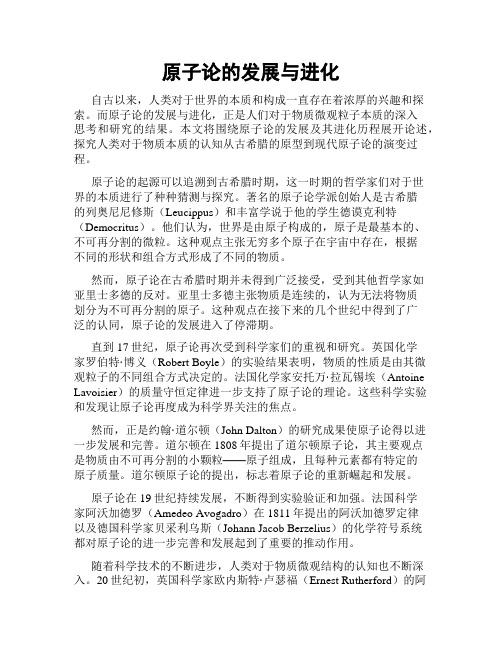
原子论的发展与进化自古以来,人类对于世界的本质和构成一直存在着浓厚的兴趣和探索。
而原子论的发展与进化,正是人们对于物质微观粒子本质的深入思考和研究的结果。
本文将围绕原子论的发展及其进化历程展开论述,探究人类对于物质本质的认知从古希腊的原型到现代原子论的演变过程。
原子论的起源可以追溯到古希腊时期,这一时期的哲学家们对于世界的本质进行了种种猜测与探究。
著名的原子论学派创始人是古希腊的列奥尼尼修斯(Leucippus)和丰富学说于他的学生德谟克利特(Democritus)。
他们认为,世界是由原子构成的,原子是最基本的、不可再分割的微粒。
这种观点主张无穷多个原子在宇宙中存在,根据不同的形状和组合方式形成了不同的物质。
然而,原子论在古希腊时期并未得到广泛接受,受到其他哲学家如亚里士多德的反对。
亚里士多德主张物质是连续的,认为无法将物质划分为不可再分割的原子。
这种观点在接下来的几个世纪中得到了广泛的认同,原子论的发展进入了停滞期。
直到17世纪,原子论再次受到科学家们的重视和研究。
英国化学家罗伯特·博义(Robert Boyle)的实验结果表明,物质的性质是由其微观粒子的不同组合方式决定的。
法国化学家安托万·拉瓦锡埃(Antoine Lavoisier)的质量守恒定律进一步支持了原子论的理论。
这些科学实验和发现让原子论再度成为科学界关注的焦点。
然而,正是约翰·道尔顿(John Dalton)的研究成果使原子论得以进一步发展和完善。
道尔顿在1808年提出了道尔顿原子论,其主要观点是物质由不可再分割的小颗粒——原子组成,且每种元素都有特定的原子质量。
道尔顿原子论的提出,标志着原子论的重新崛起和发展。
原子论在19世纪持续发展,不断得到实验验证和加强。
法国科学家阿沃加德罗(Amedeo Avogadro)在1811年提出的阿沃加德罗定律以及德国科学家贝采利乌斯(Johann Jacob Berzelius)的化学符号系统都对原子论的进一步完善和发展起到了重要的推动作用。
原子-分子论 物理学科领域术语

原子-分子论物理学科领域术语原子-分子论(Atomic-Molecular Theory)是物理学中的一个基本理论,它描述了物质由微小的、不可再分的粒子组成的结构。
这个理论是化学、物理、材料科学等领域的基础,对于我们理解物质的性质和行为至关重要。
原子-分子论最早由古希腊的哲学家德谟克利特(Democritus)提出,但直到19世纪末,当时的物理学家们才通过实验证据确认了这一理论。
根据原子-分子论,物质是由原子和分子构成的,原子是最小的、不可再分的粒子,而分子由多个原子组成。
不同的元素由不同类型的原子组成,而不同的化合物由不同类型和数量的原子组成。
原子-分子论为我们解释了许多物质的性质和现象。
例如,当我们加热水时,水分子中的氢键会断裂,水分子逐渐转变为水蒸气的原子。
当我们冷却水蒸气时,水蒸气中的水分子原子会重新结合成液态的水分子。
原子-分子论也可以解释物质的化学反应,当不同类型的原子重新排列形成新的分子时,会发生化学反应。
原子-分子论还有助于我们理解物质的宏观性质。
例如,根据原子-分子论,固体的稳定性源于原子或分子之间的相互作用力,液体的流动性源于原子或分子之间的相对运动,气体的可压缩性源于原子或分子之间的间距较大。
这些性质的理解有助于我们设计新的材料和改进现有材料的性能。
原子-分子论还解释了热力学和统计物理学中的概念。
根据原子-分子论,温度是物质中原子或分子的平均动能的度量。
热力学中的热容量和热传导也可以通过原子或分子的运动来解释。
统计物理学中的概率分布和微观状态的计数也可以通过考虑原子或分子的运动来解释。
原子-分子论的发展也推动了现代科学和技术的发展。
例如,原子-分子论有助于我们理解材料的电子结构,从而推动了电子学和半导体技术的发展。
原子-分子论还有助于我们理解光的性质,从而推动了光学和激光技术的发展。
原子-分子论还为化学合成和分析技术提供了基础。
原子-分子论是物理学中的重要理论,它描述了物质的微观结构和性质。
原子论的主要内容

原子论的主要内容一、引言原子论是物质构成的基本理论之一,认为物质是由不可再分的微小粒子组成的。
原子论的提出对于现代科学的发展起到了重要的推动作用,本文将从原子的基本概念、实验证据以及原子论的应用等方面进行阐述。
二、原子的基本概念原子是物质的基本单位,具有质量和体积。
根据原子论的观点,原子是不可再分的,也就是说,不能再继续分割下去。
原子的名称来自于古希腊语“atomos”,意为“不能分割的”。
原子由一个核和围绕核运动的电子组成,核中含有质子和中子,质子具有正电荷,中子不带电荷,而电子则具有负电荷。
三、实验证据原子论的提出并非凭空想象,而是基于大量的实验证据。
首先,托姆逊的电子发现实验证明了原子内部存在着负电的电子。
通过对阴极射线的研究,托姆逊发现了电子的存在,并提出了“酸硷模型”,将原子比作一个带有正电荷的均匀分布的球体,电子则均匀分布在球体内部。
其次,卢瑟福的散射实验提供了进一步的证据。
卢瑟福发现,当α粒子通过金属箔时,会发生散射现象,这表明原子具有一个小而带正电的核。
结合这些实验证据,原子论逐渐被科学界接受。
四、原子论的应用原子论在化学、物理和生物学等领域有着广泛的应用。
在化学中,原子论为元素周期表的建立提供了基础。
元素周期表将元素按照原子序数排列,揭示了元素的周期性规律。
在物理学中,原子论解释了物质的热性质、电性质和磁性质等现象。
在生物学中,原子论揭示了生物体的组成和生命活动的基本过程。
通过研究原子和分子水平的相互作用,人们可以更深入地了解生命的本质。
五、原子论的发展和挑战原子论的发展经历了多个阶段,包括托姆逊的酸硷模型、卢瑟福的核模型以及玻尔的量子理论等。
随着科学技术的进步,人们对原子的认识也在不断深化。
然而,原子论也面临着一些挑战。
例如,原子核内部的质子和中子构成的粒子被称为夸克,这一发现对原子核结构的理解提出了新的问题。
此外,原子的波粒二象性和量子力学等新理论的出现,也对原子论提出了新的挑战。
汤姆森原子论
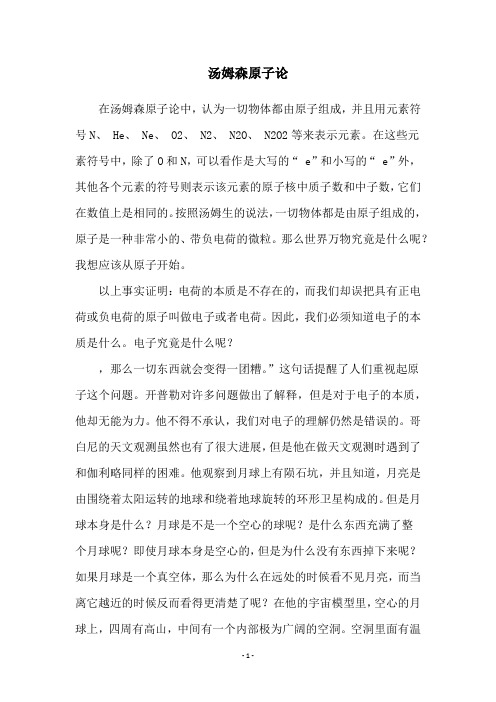
汤姆森原子论在汤姆森原子论中,认为一切物体都由原子组成,并且用元素符号N、 He、 Ne、 O2、 N2、 N2O、 N2O2等来表示元素。
在这些元素符号中,除了O和N,可以看作是大写的“ e”和小写的“ e”外,其他各个元素的符号则表示该元素的原子核中质子数和中子数,它们在数值上是相同的。
按照汤姆生的说法,一切物体都是由原子组成的,原子是一种非常小的、带负电荷的微粒。
那么世界万物究竟是什么呢?我想应该从原子开始。
以上事实证明:电荷的本质是不存在的,而我们却误把具有正电荷或负电荷的原子叫做电子或者电荷。
因此,我们必须知道电子的本质是什么。
电子究竟是什么呢?,那么一切东西就会变得一团糟。
”这句话提醒了人们重视起原子这个问题。
开普勒对许多问题做出了解释,但是对于电子的本质,他却无能为力。
他不得不承认,我们对电子的理解仍然是错误的。
哥白尼的天文观测虽然也有了很大进展,但是他在做天文观测时遇到了和伽利略同样的困难。
他观察到月球上有陨石坑,并且知道,月亮是由围绕着太阳运转的地球和绕着地球旋转的环形卫星构成的。
但是月球本身是什么?月球是不是一个空心的球呢?是什么东西充满了整个月球呢?即使月球本身是空心的,但是为什么没有东西掉下来呢?如果月球是一个真空体,那么为什么在远处的时候看不见月亮,而当离它越近的时候反而看得更清楚了呢?在他的宇宙模型里,空心的月球上,四周有高山,中间有一个内部极为广阔的空洞。
空洞里面有温暖的气体在流动。
因为这个空洞位于月球表面上,所以它就像月球的心脏。
“所以只要月球的形状没有改变,温度和压力就不会改变,它就永远不会熄灭,永远不会冷却。
因为它并不是真正的空心,而是和地球连接在一起的。
”那么空洞里面又是什么呢?哥白尼不知道。
不过在伽利略之后,才终于解开了这个千古之谜。
人类历史上的一切伟大的发现,都是从小的发现开始的。
伽利略曾经用望远镜观察天体,他已经知道火星上有水,金星上有一片云,木星上有四颗卫星。
德谟克利特的原子论
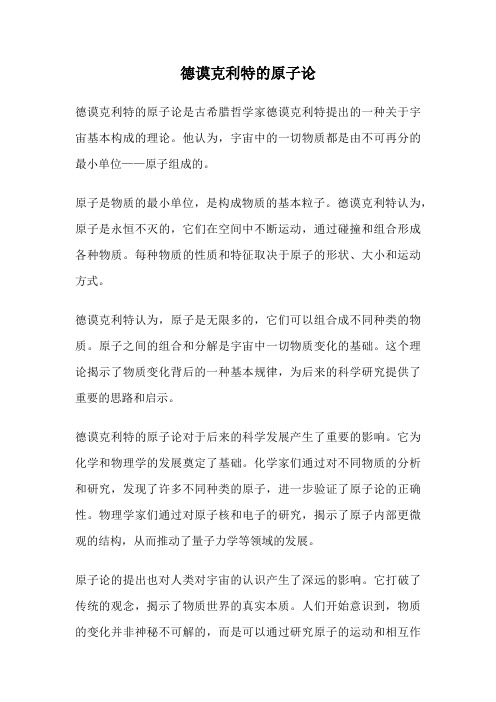
德谟克利特的原子论德谟克利特的原子论是古希腊哲学家德谟克利特提出的一种关于宇宙基本构成的理论。
他认为,宇宙中的一切物质都是由不可再分的最小单位——原子组成的。
原子是物质的最小单位,是构成物质的基本粒子。
德谟克利特认为,原子是永恒不灭的,它们在空间中不断运动,通过碰撞和组合形成各种物质。
每种物质的性质和特征取决于原子的形状、大小和运动方式。
德谟克利特认为,原子是无限多的,它们可以组合成不同种类的物质。
原子之间的组合和分解是宇宙中一切物质变化的基础。
这个理论揭示了物质变化背后的一种基本规律,为后来的科学研究提供了重要的思路和启示。
德谟克利特的原子论对于后来的科学发展产生了重要的影响。
它为化学和物理学的发展奠定了基础。
化学家们通过对不同物质的分析和研究,发现了许多不同种类的原子,进一步验证了原子论的正确性。
物理学家们通过对原子核和电子的研究,揭示了原子内部更微观的结构,从而推动了量子力学等领域的发展。
原子论的提出也对人类对宇宙的认识产生了深远的影响。
它打破了传统的观念,揭示了物质世界的真实本质。
人们开始意识到,物质的变化并非神秘不可解的,而是可以通过研究原子的运动和相互作用来理解和解释的。
然而,原子论并不是没有争议的。
在德谟克利特之后的许多哲学家和科学家对原子论提出了质疑和批评。
他们认为,原子论过于简化了宇宙的复杂性,忽视了其他因素的作用。
例如,柏拉图认为,宇宙中存在着一种更高级的形式,它们超越了原子的概念。
亚里士多德则认为,物质的变化是由于形式和物质的结合和转化。
尽管存在争议,但原子论为后来的科学研究提供了重要的思路和启示。
它为人类认识物质世界的发展做出了重要贡献。
通过对原子的研究,人们揭示了物质的微观本质,深入理解了物质的结构和性质。
德谟克利特的原子论是一种关于宇宙基本构成的理论。
它认为,宇宙中的一切物质都是由不可再分的最小单位——原子组成的。
原子通过碰撞和组合形成各种物质,它们的性质和特征取决于形状、大小和运动方式。
原子论逻辑

原子论逻辑
这一理论最早可以追溯到古希腊时期的民主克里特学派。
他们认为,空间中充满了无限多个原子,这些原子在不停运动和碰撞中形成了我们所见的各种事物。
原子是坚硬的、永恒不变的,区别只在于形状和大小的差异。
后来,古罗马哲学家叙拉基奥将原子论与逻辑学说结合,形成了更为系统的原子论逻辑体系。
他认为原子是构成万物的最小单元,彼此之间通过特定模式组合而成各种事物。
这种组合方式遵循着一定的逻辑规则,因此可以用逻辑来解释和预测事物的形成过程。
原子论逻辑给出了一种宏观和微观世界的解释模型。
一方面,宏观的可见世界是由无数微观原子构成的;另一方面,微观原子的运动和组合则符合一定的逻辑规则。
这种逻辑规则在当时被视为宇宙的根本法则,支配着一切事物的运行。
虽然现代科学对原子的概念有了更深入的认识,但原子论逻辑仍然对科学发展产生了重要影响。
它奠定了将事物视为由基本单元构成的思维模式,并注重对这些基本单元的研究。
此外,它倡导用逻辑和理性的方式来认识世界,这一点对于科学方法论的形成也起到了重要作用。
原子论逻辑是人类认识世界的一种重要尝试,虽然在细节上有待完善,但其中蕴含的基本思路和价值观念至今仍有重要意义。
西方原子论
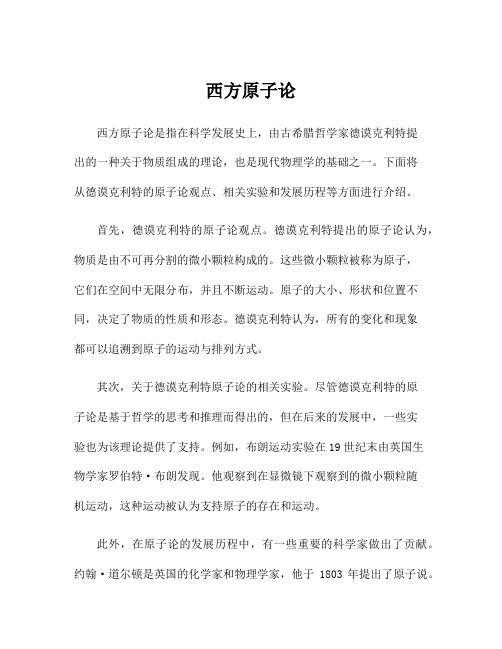
西方原子论西方原子论是指在科学发展史上,由古希腊哲学家德谟克利特提出的一种关于物质组成的理论,也是现代物理学的基础之一。
下面将从德谟克利特的原子论观点、相关实验和发展历程等方面进行介绍。
首先,德谟克利特的原子论观点。
德谟克利特提出的原子论认为,物质是由不可再分割的微小颗粒构成的。
这些微小颗粒被称为原子,它们在空间中无限分布,并且不断运动。
原子的大小、形状和位置不同,决定了物质的性质和形态。
德谟克利特认为,所有的变化和现象都可以追溯到原子的运动与排列方式。
其次,关于德谟克利特原子论的相关实验。
尽管德谟克利特的原子论是基于哲学的思考和推理而得出的,但在后来的发展中,一些实验也为该理论提供了支持。
例如,布朗运动实验在19世纪末由英国生物学家罗伯特·布朗发现。
他观察到在显微镜下观察到的微小颗粒随机运动,这种运动被认为支持原子的存在和运动。
此外,在原子论的发展历程中,有一些重要的科学家做出了贡献。
约翰·道尔顿是英国的化学家和物理学家,他于1803年提出了原子说。
道尔顿的原子说主张物质由不可再分割的微小颗粒组成,不同的元素由不同种类的原子组成,并且化学反应是由原子的重组和重新排列引起的。
道尔顿通过对化学实验的观察和定量分析,为原子论提供了一定的实证依据。
再者,后来的科学家推进了原子论的发展。
例如,爱尔兰物理学家约翰·托姆逊在1897年通过阴极射线实验发现了电子,证实了原子是由正电荷和负电荷之间相互平衡的。
这一发现奠定了原子核模型的基础,即原子核由带正电荷的质子组成,而电子则绕核旋转。
此后,劳厄尔和斯库特等科学家通过放射性珍稀元素的实验发现了中子的存在,进一步完善了原子核模型。
最后,在20世纪初,量子力学的发展进一步推动了原子论的进展。
薛定谔方程等理论为原子的行为和性质提供了更精确的解释,如电子能级、波粒二象性等。
此外,通过核反应和粒子加速器等实验,科学家们不断深入研究原子的结构和性质。
古希腊原子论和当代物理学原子论
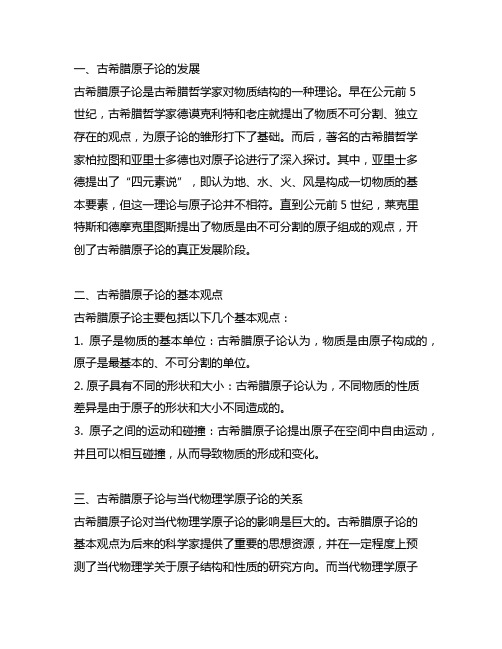
一、古希腊原子论的发展古希腊原子论是古希腊哲学家对物质结构的一种理论。
早在公元前5世纪,古希腊哲学家德谟克利特和老庄就提出了物质不可分割、独立存在的观点,为原子论的雏形打下了基础。
而后,著名的古希腊哲学家柏拉图和亚里士多德也对原子论进行了深入探讨。
其中,亚里士多德提出了“四元素说”,即认为地、水、火、风是构成一切物质的基本要素,但这一理论与原子论并不相符。
直到公元前5世纪,莱克里特斯和德摩克里图斯提出了物质是由不可分割的原子组成的观点,开创了古希腊原子论的真正发展阶段。
二、古希腊原子论的基本观点古希腊原子论主要包括以下几个基本观点:1. 原子是物质的基本单位:古希腊原子论认为,物质是由原子构成的,原子是最基本的、不可分割的单位。
2. 原子具有不同的形状和大小:古希腊原子论认为,不同物质的性质差异是由于原子的形状和大小不同造成的。
3. 原子之间的运动和碰撞:古希腊原子论提出原子在空间中自由运动,并且可以相互碰撞,从而导致物质的形成和变化。
三、古希腊原子论与当代物理学原子论的关系古希腊原子论对当代物理学原子论的影响是巨大的。
古希腊原子论的基本观点为后来的科学家提供了重要的思想资源,并在一定程度上预测了当代物理学关于原子结构和性质的研究方向。
而当代物理学原子论主要是以量子力学为基础的,其基本观点包括原子是由云层中的电子以及核中的质子和中子组成的,而这些基本粒子的运动和相互作用决定了物质的性质和行为。
四、古希腊原子论与当代物理学原子论的异同古希腊原子论与当代物理学原子论在一些基本观点上存在着一定的异同。
古希腊原子论认为原子是不可分割的,而当代物理学原子论认为原子内部还存在着更加微观的粒子。
古希腊原子论主张原子之间可以相互碰撞,而当代物理学原子论更注重原子内部的基本粒子的运动和相互作用。
五、结论古希腊原子论是古代哲学的重要发展阶段,其思想对后来当代物理学原子论的形成有着深远的影响。
尽管古希腊原子论与当代物理学原子论在某些基本观点上存在着一定的不同,但其共同点更多地体现在对物质结构和基本粒子的关注上。
英语单词精解系列[高中人教必修5单元1]五
![英语单词精解系列[高中人教必修5单元1]五](https://img.taocdn.com/s3/m/69f52c88f111f18582d05a0e.png)
英语单词精解系列[高中入教必修5单元1]五theory音标_________________________________________________________________________________________ 英reian]美reiari]附加_________________________________________________________________________________________ [复数theories ]_____________________________________________________________________________n.理论;原理:学说:推测短语_________________________________________________________________________________________ information theory:信息论;信息理论;情报理论expectancy theory:期望理论;期望值理论;期望理論;期待理论prospect theory:展望理论;前景理论;预期理论;期望理论Hybrid Theory:混合理论;混公道论;混合实际;杂交说Chaos Theory:混沌理论;混沌科学;浑沌理论;细胞分裂之混沌理论Atomic theory:原子理论;kinetic theory:原子论;原子学说;原子说Automata theory:分子运动论;运动论;动力学理论;动力论string theory:自动机理论;自动控制原理;翻译例句_________________________________________________________________________________________1.N-VAR A theory is a formal idea or set of ideas that is intended to explain something. 理论2.N-COUNT If you have a theory about something, you have your own opinion about it which you cannot prove butwhich you think is true. 观点基础理论4.PHRASE You use in theory to say that although something is supposed to be true or to happen in the way stated, it may not in fact be true or happen in that way. 从理论上说音标defeat英[d"i :t]美[drfit]释义 _________________________________________________________________________________________ vt.击败,战胜:挫败;使...失败n.失败的事实:击败的行为短语 _________________________________________________________________________________________Embracing Defeat:拥抱战败二次大战后的日本人;拥抱战败Concede Defeat:愿赌服输;承认败选;认输;承认失败take defeat:承认失败;接收失败complete defeat:完败;彻底失败Tone defeat:音调控制启动开关;音调失效defeat switch:消除开关inevitable defeat:丧志屈服;必然的失败Duplication defeat:复制失败defeat the:落败的例句 _________________________________________________________________________________________1. V-T If you defeat someone, you win a victory over them in a battle, game, or contest ・ 击败2.V-T If a proposal or motion in a debate is defeated , more people vote against it than for it.(以多数票)挫败[usu passive]3. V-T If a task or a problem defeats you, it is so difficult that you cannot do it or solve it. 难倒例:The book he most wan ted to write was the one which n early defeated him.他最想写的书恰恰是几乎难倒他的那一本。
朴素原子论
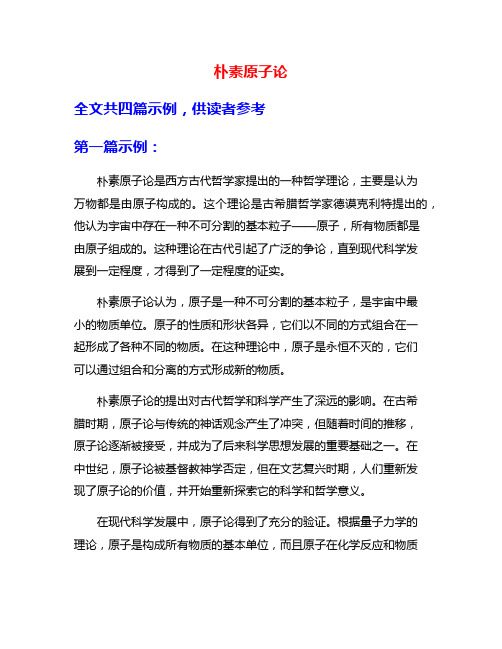
朴素原子论全文共四篇示例,供读者参考第一篇示例:朴素原子论是西方古代哲学家提出的一种哲学理论,主要是认为万物都是由原子构成的。
这个理论是古希腊哲学家德谟克利特提出的,他认为宇宙中存在一种不可分割的基本粒子——原子,所有物质都是由原子组成的。
这种理论在古代引起了广泛的争论,直到现代科学发展到一定程度,才得到了一定程度的证实。
朴素原子论认为,原子是一种不可分割的基本粒子,是宇宙中最小的物质单位。
原子的性质和形状各异,它们以不同的方式组合在一起形成了各种不同的物质。
在这种理论中,原子是永恒不灭的,它们可以通过组合和分离的方式形成新的物质。
朴素原子论的提出对古代哲学和科学产生了深远的影响。
在古希腊时期,原子论与传统的神话观念产生了冲突,但随着时间的推移,原子论逐渐被接受,并成为了后来科学思想发展的重要基础之一。
在中世纪,原子论被基督教神学否定,但在文艺复兴时期,人们重新发现了原子论的价值,并开始重新探索它的科学和哲学意义。
在现代科学发展中,原子论得到了充分的验证。
根据量子力学的理论,原子是构成所有物质的基本单位,而且原子在化学反应和物质变化中起着至关重要的作用。
通过对原子的研究,科学家们不断发现新的物质和新的现象,为人类认识世界提供了更加深入的基础。
朴素原子论虽然在古代被认为是一种简单和幼稚的理论,但它确实为后来的科学思想和研究提供了重要的启示。
原子论的提出,为人类认识物质世界奠定了基础,推动了自然科学的发展。
在今天,我们依然可以从原子论中找到许多有价值的启示,它让我们更加谦逊地认识到,人类对于宇宙的认知还远远没有达到极限,我们需要继续努力,探索更多未知的领域。
【文末】。
第二篇示例:朴素原子论是一种古代哲学思想,认为万物都是由原子构成的。
这个理论最早由古希腊哲学家德谟克利特提出,后来由其弟子庄子、公孙龙等人进一步发展和完善。
朴素原子论认为,一切事物都是由微小的、不可分割的原子构成的,这些原子以不同的形态和排列组合形成了世界上所有的物质。
原子论
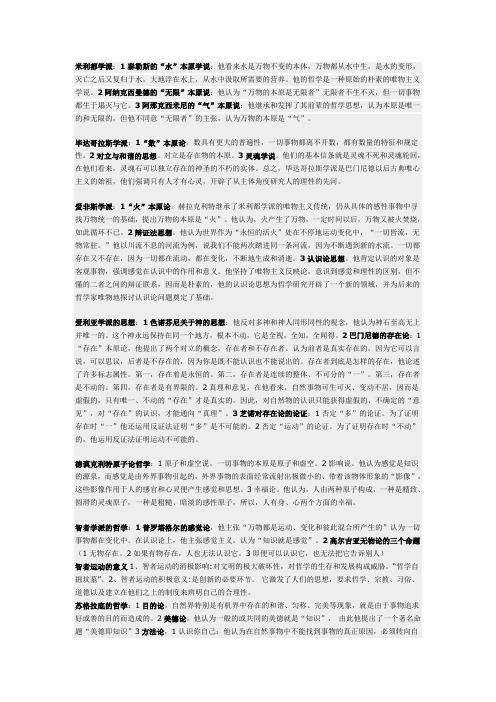
米利都学派:1泰勒斯的“水”本原学说:他看来水是万物不变的本体,万物都从水中生,是水的变形,灭亡之后又复归于水,大地浮在水上,从水中汲取所需要的营养。
他的哲学是一种原始的朴素的唯物主义学说。
2阿纳克西曼德的“无限”本原说:他认为“万物的本原是无限者”无限者不生不灭,但一切事物都生于塌灭与它。
3阿那克西米尼的“气”本原说:他继承和发挥了其前辈的哲学思想,认为本原是唯一的和无限的,但他不同意“无限者”的主张,认为万物的本原是“气”。
毕达哥拉斯学派:1“数”本原论。
数具有更大的普遍性,一切事物都离不开数,都有数量的特征和规定性。
2对立与和谐的思想。
对立是存在物的本原。
3灵魂学说。
他们的基本信条就是灵魂不死和灵魂轮回,在他们看来,灵魂石可以独立存在的神圣的不朽的实体。
总之,毕达哥拉斯学派是巴门尼德以后古典唯心主义的始祖,他们强调只有人才有心灵,开辟了从主体角度研究人的理性的先河。
爱非斯学派:1“火”本原论。
赫拉克利特继承了米利都学派的唯物主义传统,仍从具体的感性事物中寻找万物统一的基础,提出万物的本原是“火”。
他认为,火产生了万物,一定时间以后,万物又被火焚烧,如此循环不已。
2辩证法思想。
他认为世界作为“永恒的活火”处在不停地运动变化中,“一切皆流,无物常驻。
”他以川流不息的河流为例,说我们不能两次踏进同一条河流,因为不断遇到新的水流。
一切都存在又不存在,因为一切都在流动,都在变化,不断地生成和消逝。
3认识论思想。
他肯定认识的对象是客观事物,强调感觉在认识中的作用和意义。
他坚持了唯物主义反映论,意识到感觉和理性的区别,但不懂的二者之间的辩证联系,因而是朴素的,他的认识论思想为哲学研究开辟了一个新的领域,并为后来的哲学家唯物地探讨认识论问题奠定了基础。
爱利亚学派的思想:1色诺芬尼关于神的思想:他反对多神和神人同形同性的观念,他认为神石至高无上并唯一的。
这个神永远保持在同一个地方,根本不动,它是全视,全知,全闻得。
我国古代原子论

参考资料●2.我国古代朴素的原子论大约在西周时代,人们就注意到物质的分割问题了.那时虽然没有什么理论,但在造字中多少透出一点信息来.譬如“小”字,在最原始的文字里只作三点,就表示细小的意思.在西周时期的金文(就是铸在青铜器上的文字)里就写作“小”.据东汉的许慎解释:“小”代表一根东西,“八”表示劈为两半,意思是说:把一根东西,劈了又劈,剩下的就是“小”的形象.但是究竟能“小”到什么程度呢?那“小”可不可以再劈呢?这里还找不到答案.战国时代儒家著作《中庸》里就比较明确地指出:“语小,天下莫能破焉”.这段话的意思,还是儒家权威、宋代朱熹(公元1130~1200)解释得最清楚,他说:“天下莫能破是无内,谓如物有至小而可破作两者,是中着得一物在;若无内则是至小,更不容破了.”这里所说的“莫能破”、“无内”,也就是不可分割的意思.这就论证了物质有不可再分割的最原始单位,就相当于古典原子学说中的原子概念.在英文里,现在被译成“原子”的Atom一词,原来也是不可分割的意思.本世纪初,严复翻译的《穆勒名学》一书,第一次把Atom一词介绍到我国,当时他就译为“莫破”,而把现译为“原子论”的Atomic Theory译为“莫破质点律”,大概就是以《中庸》书里的字句为渊源的.而“无内”一词,并不始于朱熹,也是在战国时期,有个名叫惠施的人(约公元前365~前310),曾说过一句话,叫做“其小无内,谓之小一”.意思是说“小一”这东西,不再有内,也就无法再分割了,即是最原始的微粒.主张不可无限分割的一派,最著名的是战国时期的墨家.墨家著作的总集叫做《墨子》,其中有篇《墨经》,里面专门有两条谈论这个问题,说得很透彻.一条《经》文说:“端,体之无序最前者也.”①仰译成现代语就是说:“端”是组成物体(“体”)的无可分割(“无序”)的最原始的东西(“最前者”).这“端”就是原子的概念了.“端”为什么不可分割呢?解释这条《经》文的《经说》指出:“端是无同也”,②意思是说,一个“端”里,没有共合的东西,所以无可分割.《墨经》另有一条用逻辑推理的方法去论证物质的不可无限分割.《经》文说“非半弗则不动,说在端”.“ ”就是砍的意思,译成现代语就是:不能分为两半的东西是不能砍开的,也就对它不能有所动作,它便是“端”了.这条《经说》解释道:“非:半.进前取也;前则中无为半,犹端也.前后取:则端中也.必半,毋与非半,不可薪也”.墨家认为,砍一个物体,一定分为两半(“ 必半”),如没有或不能分为两半的就是不可砍开的(“毋与非半,不可也”),如将一物体不断地分半,最后便能得到一个最原始的“端”.这有两种取法,一为“进前取”,即从后至前,一半一半地取来,到了最前处必有一个不能再分半的“端”留着.另一种是“前后取”,即在一根东西前后两头同时向中央取去,则那个不可分半的“端”,必留在当中.这里不但作出比较缜密的论证,而且他们可能认为组成任何物体的原子数目,总不外乎单数或双数两种情况,所以用“进前取”与“前后取”两种办法总可以得到最小的“端”.这种研究可以说是深入细致的,是我国古代原子论的杰出代表,和古希腊的原子论者德谟克里特正可以相互辉映.主张物质可以无限分割的,以战国时期叫作“辩者”的一派为代表,其中最著名的是公孙龙(约公元前320~前250).他有一句有名的话,叫做“一尺之棰,日取其半,万世不竭.”“棰”就是木杖.意思说,一条尺把长的木杖,今天截取一半,明天截取一半的一半,依此截取下去,永远截不完.这等于说木杖可以无限地分割,也就是说物质的组成是连续的,正与上面惠施的“小一”理论尖锐地对立着.公孙龙臆测到物质的无限可分,应该说是符合于辩证法的.现代物理学正不断发现着越来越多的所谓“基本粒子”,揭示出物质的无限可分性,从这个意义上看,2000年前的公孙龙的臆想实在令人吃惊!另一方面,那些主张物质不可无限分割的人,则是认识到了分割的“关节”.他们提出的理论,是古典原子说的雏形,也是我国科学史上的光辉遗产!。
原子论

• 量子论与实证论
小结
• 整个人类的思想都进入一个固定的模式之中 • 三阶段 德谟克利特——牛顿(自然哲学的思想,作为哲学思想和方 法的原子论与作为科学思想和方法的原子论融合) 伽桑狄(移植到力学中,牛顿机械原子论的建立) 20世纪(影响科学家的活动,决定理论科学家的思想方法) • 原子论给整个自然科学的发展带来的影响是不容低估的 • 原子论方法是一种带有原理性的方法,比任何一个具体的 科学理论的提出都更能震撼自然科学的基础。
N
• 一切可感觉的特征都归结到原子不同的联合——造成事物的产生,原 子的解散和分离造成事物的灭亡 • 它是一种理性的方法(分析),并不是经验的方法;原子虽然可以当做 物质的,但它是非感觉的,是纯粹理性的;原子和虚空不是经验中的 事物,我们凭借任何仪器或借助感官都无法观测到他们,观念性的, 想象中的 • 它更容易为自然科学家所接受
在漩涡运动中,轻的物体被抛到周围的虚空里;其余重的物质则留在漩涡中 心,它们更加紧密地结合而形成最初的球形体。这个球形体由于来自中心的 推动力而继续旋转着,邻近的物体不断附着在上面,最初是潮湿的和泥泞的, 后来渐渐干涸(地球)并在漩涡中旋转,后来成为燃烧的,这样完成了星球 的性质,在漩涡运动中被抛向外面的最轻物体燃烧起来,从而发出亮光,日、 月、星辰也就产生了。
很容易说明物体的感 觉性质——性质的不同在于原子的 不同、数量及结合方式的不同
• 理性方法是区分事物感觉性质(多样Байду номын сангаас)和事物的本质属性(统一性) 的有效方法
。
世界的本原归为原子 及原子自己的运动 ,反对一个外来的 本原或世界没有本原
数学和谐的自然图景 引导人们到上帝那儿 去寻求自然和谐的原因
数的统一性不那么直接
留基伯原子论主要观点

留基伯原子论主要观点源于埃及古埃及年代的原子论,在古希腊时期被现代化,由古希腊哲学家希拉克和苏格拉底等人发展而来。
在古代埃及、古希腊的文献中,原子论被看作一种抽象的哲学概念,而公元前460年,希腊哲学家苏格拉底认为,原子是一种最基本的组成物质的分子,没有细分的可能性。
因此,尽管希腊哲学家的原子理论有其自身的缺陷,但它提供了重要的观点,并且引发了后续学者对原子深入探究的激情。
1803年,爱尔兰物理学家威廉路易斯留基伯(William Lawes)提出了原子论的新观念,这一新观念被称为留基伯原子论(Rutherford Atomic Theory)。
他的观点是,原子是由三个不可分割的组成部分组成,即原子核(nuclear)、电子(electron)和电子云(electron cloud)。
核是原子的中心部分,是原子最重要的组成部分,其由特定元素的质子和中子组成,质子和中子的数量决定了原子的元素性质,从而决定了原子组成物质的方式,包括其物理和化学属性。
电子是原子周围静止的小质点,它们绕着原子核运动,以及电子云,电子云是由无定形的电子组成的,它们可以运动在原子的内部和外部,也可以在原子之间移动。
留基伯还认为,原子受到内部力的影响,即电子环绕原子核的力,以及原子之间互相作用的力,如电磁力等。
因此,它可用来解释现象,如构成物质的原子运动和反应机制。
此外,他还提出,由于电子运动的不可预测性,原子的行为也会有变化,因此经常可以解释物质的化学反应机理和性质。
留基伯的原子论也提出了宇宙中存在的原子可以超越物理界限的观点。
例如,留基伯指出,原子是一种微小的物体,并且可以穿越时间和空间,物质经历变化的同时,它仍然保持不变,因此可以在变化中有所研究。
总之,留基伯原子论是一个历史悠久的原子论,它对元素本质的解释对当代物理学产生了重大影响。
他提出,原子的组成部分,如原子核、电子和电子云,它们之间的相互作用,以及原子的行为受特定力的影响,为当代物理学家提供了重要的参考研究。
原子论是谁提出的
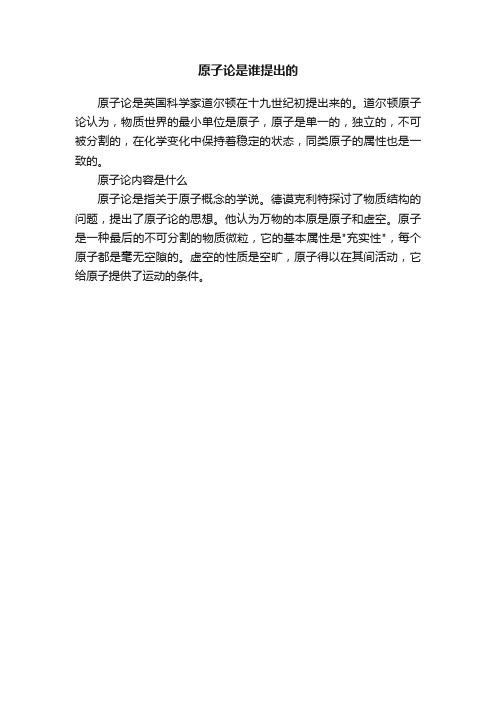
原子论是谁提出的
原子论是英国科学家道尔顿在十九世纪初提出来的。
道尔顿原子论认为,物质世界的最小单位是原子,原子是单一的,独立的,不可被分割的,在化学变化中保持着稳定的状态,同类原子的属性也是一致的。
原子论内容是什么
原子论是指关于原子概念的学说。
德谟克利特探讨了物质结构的问题,提出了原子论的思想。
他认为万物的本原是原子和虚空。
原子是一种最后的不可分割的物质微粒,它的基本属性是"充实性",每个原子都是毫无空隙的。
虚空的性质是空旷,原子得以在其间活动,它给原子提供了运动的条件。
- 1、下载文档前请自行甄别文档内容的完整性,平台不提供额外的编辑、内容补充、找答案等附加服务。
- 2、"仅部分预览"的文档,不可在线预览部分如存在完整性等问题,可反馈申请退款(可完整预览的文档不适用该条件!)。
- 3、如文档侵犯您的权益,请联系客服反馈,我们会尽快为您处理(人工客服工作时间:9:00-18:30)。
– Solids have a definite volume
• Have a definite shape.
• Mixtures and Pure Substances
– A mixture has unlike parts and a composition that varies from sample to sample – A heterogeneous mixture has physically distinct parts with different properties. – A homogeneous mixture is the same throughout the sample – Pure substances are substances with a fixed composition
• Discovery of Modern Elements
– Antoine Lavoisier suggested that burning was actually a chemical combination with oxygen. – Lavoisier realized that there needed to be a new concept of elements, compounds, and chemical change. – We now know that there are 89 naturally-occurring elements and at least 23 short-lived and artificially prepared.
Elements and the Periodic Table
• Classification is arranging items into groups or categories according to some criteria. • The act of classifying creates a pattern that helps you recognize and understand the behavior of fish, chemicals, or any matter in your surroundings.
Atomic theory
Dalton’s Postulates
1. Every element is composed of tiny particles called atoms 2. All atoms of a given element are identical 1. Atoms of different elements have different properties 3. Atoms of an element are NOT changed into atoms of another element by chemical processes 1. Matter can neither be created nor destroyed 4. Compounds are formed when atoms of more than one element combine
Order Particles fixed in position
Gas
Liquid
Solid
• Solids, Liquids, and Gases
– Gases have no defined shape or defined volume
• Low density
– Liquids flow and can be poured from one container to another
• Here are some of the symbols Dalton used for atoms of elements and molecules of compounds. He probably used a circle for each because, like the ancient Greeks, he thought of atoms as tiny, round hard spheres.
• Lavoisier heated a measured amount of mercury to form the red oxide of mercury. He measured the amount of oxygen removed from the jar and the amount of red oxide formed. When the reaction was reversed, he found the original amounts of mercury and oxygen.
• Priestley produced a gas (oxygen) by using sunlight to heat mercuric oxide kept in a closed container. The oxygen forced some of the mercury out of the jar as it was produced, increasing the volume about five times.
• A classification scheme for matter.
– A physical change is a change that does not alter the identity of the matter. – A chemical change is a change that does alter the identity of the matter. – A compound is a pure substance that can be decomposed by a chemical change into simpler substances with a fixed mass ratio – An element is a pure substance which cannot be broken down into anything simpler by either physical or chemical means.
• Names of Elements
– The first 103 elements have internationally accepted names, which are derived from:
• The compound or substance in which the element was discovered • An unusual or identifying property of the element • Places, cities, and countries • Famous scientists • Greek mythology • Astronomical objects.
Dalton’s Laws
1. The Law of Constant Composition:
“Any given compound always consists of the same atoms and the same ratio of atoms. For example, water always consists of oxygen and hydrogen atoms, and it is always 89 percent oxygen by mass and 11 percent hydrogen by mass”
• Sugar (A) is a compound that can be easily decomposed to simpler substances by heating. (B) One of the simpler substances is the black element carbon, which cannot be further decomposed by chemical or physical means.
EXAMPLE
Isopropyl alcohol is a A. heterogeneous mixture B. homogeneous mixture C. pure substance
D. Compound
E. pure substance and compound
ቤተ መጻሕፍቲ ባይዱ
E
• Elements
• Reconsidering the Fire Element
– The phlogiston theory viewed phlogiston as a component of all matter. – The burning of a material was considered to be the escaping of phlogiston from the matter. – If a material did not burn, it was considered to contain no phlogiston.
• The phlogiston theory. (A) In this theory, burning was considered to be the escape of phlogiston into the air. (B) Smelting combined phlogiston-poor ore with phlogiston from a fire to make a metal. (C) Metal rusting was considered to be the slow escape of phlogiston from a metal into the air.
